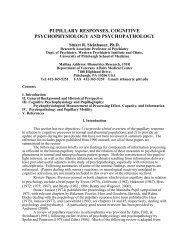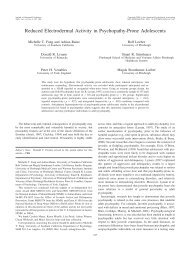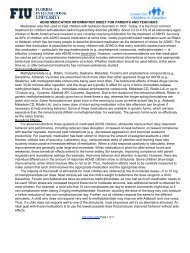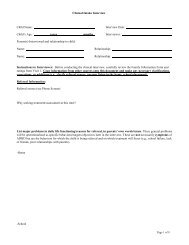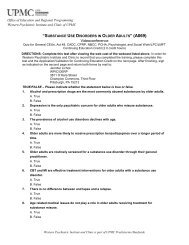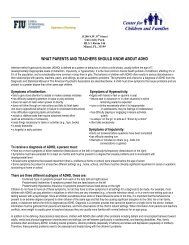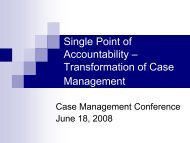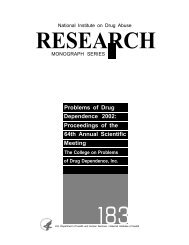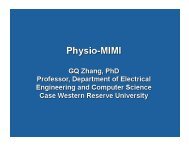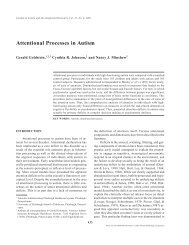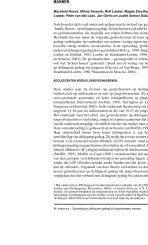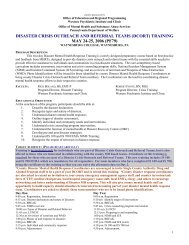The Evolution of Autism Research: A Child Neurologist's Perspective
The Evolution of Autism Research: A Child Neurologist's Perspective
The Evolution of Autism Research: A Child Neurologist's Perspective
You also want an ePaper? Increase the reach of your titles
YUMPU automatically turns print PDFs into web optimized ePapers that Google loves.
<strong>The</strong> <strong>Evolution</strong> <strong>of</strong> <strong>Autism</strong> <strong>Research</strong>:A <strong>Child</strong> Neurologist’s <strong>Perspective</strong>March 2, 2012Cleveland <strong>Autism</strong> ConsortiumNancy J. Minshew, M.D.<strong>Child</strong> Neurologist & Pr<strong>of</strong>essor <strong>of</strong> Psychiatry & NeurologyDirector <strong>of</strong> U. Pittsburgh-Carnegie Mellon ACEminshewnj@upmc.edu; www.pittautismresearch.org
Progress Comes From ParticipationWe wish to honor those individuals and familieswho have believed in research andbeen committed to participating,again and again.
A Mission Statement For <strong>Autism</strong> <strong>Research</strong>‣ Significantly advance our understanding <strong>of</strong> thecauses <strong>of</strong> ASD to enable significant advances intreatment and services.‣ To be effective in these roles, an autism centerrequires close and synergistic interactionsbetween scientists in many fields & clinicians.‣ Translational efforts require adaptationsspecifically for community pr<strong>of</strong>essionals,educators, parents/families & affected individualsinto team.
What Does ‘cause’ Mean?EtiologyPathophysiologyFunctional analysis <strong>of</strong> behaviorDisconnection between behavior & brain
Why Is Cause Important?Defining MechanismsThat Lead To More efficacious treatmentsTargeting mechanisms that are increasinglyproximal to originating events
From DNA to Behavior:<strong>The</strong> Top 10 <strong>of</strong> 2007 (cont’d.)A Complex Sequence <strong>of</strong> MechanismsAbnormalities in Genetic Code for Brain Development1. Spontaneous Mutations: Increased rate <strong>of</strong> “de novo” copy numbervariations: submicroscopic deletions or duplications <strong>of</strong> DNA sequences.More common in simplex than multiplex families. Opened door to twogenetic mechanisms: inherited gene mutations and spontaneous copyAbnormal Mechanisms <strong>of</strong> Brain Developmentnumber mutations- instability in replication <strong>of</strong> DNA2. Potential reversal <strong>of</strong> Neurodevelopmental Disorders (in Fragile X, Rett &Angelman Syndromes) in adult miceStructural and Functional Abnormalities <strong>of</strong> BrainCognitive & Neurological AbnormalitiesBehavioral Syndrome
Where Are We Coming FromAutistic Disorder: DSM IV3 Core SymptomsAssociated symptoms: sensory, motorCo-morbid Conditions: intellectual disability,ADHD, seizures, mood problems, long list <strong>of</strong>behavior issues (Pg. 71-72 TR version)Not a valid conceptualization and no longerfunctional. Do we wonder why families &clinicians are confused?
Sir Michael Rutter’s Question, 2007Q: Is the constellation inherent in a cohesivesyndrome or is it an artifact <strong>of</strong> diagnosticpractice?What causes these signs and symptoms to co-occur?Courtesy <strong>of</strong> Michael Rutter, 2007 “<strong>Autism</strong>: Clinical features and research challenges”
Neurologic Principles <strong>of</strong> Disease• Brain disturbances produce a constellation <strong>of</strong>neurologic signs & symptoms: symptoms/signsequally important• <strong>The</strong> constellation & mode <strong>of</strong> presentation reflectthe underlying brain mechanism and its location• Impairments present when the time in braindevelopment comes for that skill to appear
<strong>Child</strong> Neurologists Differential Diagnosis ForDe Novo Neurodevelopmental Disorders• Organogenesis• Neuronal proliferation*• Glial proliferation, migration• Neuronal migration** CNTNP2• Neuronal organization***• Myelination*Implicated in ASD
<strong>Child</strong> Neurologists Best GuessAbout Neurological Basis <strong>of</strong> <strong>Autism</strong>• Abnormalities in complex behavior, cognition,language, intellectual disability, seizures• No primary sensory deficit• No long tract signs• No focal findings (dyslexia, visuospatial deficits)• De novo developmental disorderAssociation corticesDistributed neural network disorderDisorder <strong>of</strong> neuronal organization
Discriminant Function Analysis 1 :Domains With DeficitsDomainTests Passing TolerancePercentCorrectKappaMotor Grooved Pegboard; Trail Making A 75.80 0.52ComplexLanguageComplexMemoryReasoningK-TEA Reading Comprehension; VerbalAbsurdities; Token TestNonverbal Selective Reminding-ConsistentLong Term Retrieval; WMS-R StoryRecall-Delayed Recall; Rey-OsterriethFigure-Delayed Recall20 Questions; Picture Absurdities; TrailMaking B72.70 0.4577.30 0.5575.8 0.521Based on 33 individually matched pairs <strong>of</strong> autistic & control subjects (Neuropsychologic Functioning in<strong>Autism</strong>: Pr<strong>of</strong>ile <strong>of</strong> a Complex Information Processing Disorder, JINS, 3:303-316, 1997)
Discriminant Function Analysis:Domains Without Deficits 3DomainTests Passing TolerancePercentCorrectKappa1Attention Letter Cancellation; Number Cancellation 66.70 0.33SensoryPerceptionSimpleLanguageSimpleMemoryFinger Tip Writing; Luria-NebraskaSharp/Dull Tactile Scale itemK-TEA Reading; K-TEA Spelling WRMT-RAttack; Controlled Oral Word Association1Kappa below .40 indicates poor agreement beyond chance2Significant Kappa reflects superior performance by autistic subjects3Based on 33 individually age, IQ, gender matched pairs <strong>of</strong> subjects64.40 0.2971.20 0.42 2CVLT Trial 1 65.20 0.30Visuo-Spatial WAIS-R Block Design 56.10 0.12
Pattern <strong>of</strong> Abilities in Major Domains inHigh Functioning <strong>Autism</strong>Intact or EnhancedCognitive Weaknesses• Attention• Sensory Perception• Elementary Motor• Simple Memory• Formal Language• Rule-learning• Visuospatial processing• Complex Sensory• Complex Motor• Complex Memory• Complex Language• Concept-formation• Face Recognition
What is the pattern? A Two-PartDisturbance in Information Processing• Elementary abilities intact or enhanced• Information processing capacity constrainedintegrativeprocessing disproportionatelyimpairedInference: higher order brain circuitry is underdeveloped- over-reliance or over-development <strong>of</strong>lower order visual circuitry for functioning;neuronal organizational events disrupted
fMRI Activation During a SpatialWorking Memory Task (Courtesy John Sweeney)Neurotypical Group<strong>Autism</strong> Group
How altered is information processing inautism? What is the neural basis <strong>of</strong> this?Details:elementary perception at its most elementaryFacts:meaning associated with detailsKnowledge:connecting related details; understandingWisdom:capacity to use knowledge to negotiate life
Cortical activation & synchronization duringsentence comprehension in HFA subjectsMarcel JustVlad CherkasskyTim KellerNancy MinshewCenter for CognitiveBrain ImagingCarnegie MellonJust et al. 2004, Brain 127: 1811-1821
Reliably lower functionalconnectivity for autismparticipants betweenpairs <strong>of</strong> key areas duringsentence comprehension(red end <strong>of</strong> scale denoteslower connectivity)
Reliable differencesin functionalconnectivity: autismgroup has lowerfunctionalconnectivity butsame rank order
How Does the Brain Classify Words?Results <strong>of</strong> Recent fMRI Studies• Encoding by the brain is distributed- involvesmultiple brain regions- leads to flexibility• Each word encoded according to four attributes inadults:• Eating• Shelter• Manipulation• Number <strong>of</strong> characters in word• Vital to design <strong>of</strong> early interventions
Brain Affected Broadly But SelectivelyCortical-Cortical ConnectionsCortical-amygdalaCortical-striate
Figure 2. Occipital–frontal (OFC) Z score measurements (N 195) with meanestimated growth trajectory for 28 children with autism spectrum disorder (hierarchicallinear model two-piece linearmodel centered at 12 months).
What Are Infant Siblings Teaching UsAbout <strong>Autism</strong> in Infants? Rogers, 2009• Home movies showed signs <strong>of</strong> autism long beforediagnosis• Key Q: What are the first behavioralcharacteristics that predict the development <strong>of</strong>autism?• Method: study <strong>of</strong> infants with an older siblingdiagnosed with autism- “infant sibs”
“First Signs”:Visual Regard-Sensory-Motor• Socially normal at 6 months• Unusual visual regard at 9-12 mos• Repetitive waving <strong>of</strong> arms and hands at 9-12 mos• Sensory-related behaviors: under and overresponsiveness at 9-12 months• Temperament: no differences at 6 mos, over timetemperamentally more difficult with more intensedistress and more time fixating on objects;accompanies- does not predate- sx
Social, Communication, Dysregulation Signs• Delays in verbal and nonverbal language at 12months but not earlier• Developmental differences at 12 mos onstandardized tests• Exhibit faster or slower deceleration in developing• Gap widens between 12 & 24 months and beyond• At 24 months, emotional and behavioraldysregulation distinguish infant sibs dx with ASD
Developmental Characteristics <strong>of</strong> Infant Sibs:<strong>The</strong> Surprises• Lack <strong>of</strong> behavioral markers at 6 months;• Socially normal at 6 months• Onset: not early or regressive but rather slower orfaster mounting <strong>of</strong> symptoms- a deceleration <strong>of</strong>development: core symptoms present at 12 mos andgrow more severe over time• “Associated symptoms” are integral aspects <strong>of</strong> ASDirritability,sensory reactivity, hyperactivity,inattention, mood lability, poor gross motordevelopment
Developmental Characteristics <strong>of</strong> Infant Sibs:Conclusions• “<strong>The</strong>se findings do not support the view thatautism is primarily a social-communicativedisorder and instead suggest that autism disruptsmultiple aspects <strong>of</strong> development rathersimultaneously.”• “<strong>Child</strong>ren’s developmental rates are deceleratingmarkedly in a 12 month period, with IQs droppingfrom average to below 50 for some children.”Sally Rogers, 2009
Developmental Characteristics <strong>of</strong> Infant Sibs:Conclusions• “<strong>The</strong>se findings do not support the view thatautism is primarily a social-communicativedisorder and instead suggest that autism disruptsmultiple aspects <strong>of</strong> development rathersimultaneously.”• “<strong>Child</strong>ren’s developmental rates are deceleratingmarkedly in a 12 month period, with IQs droppingfrom average to below 50 for some children.”Sally Rogers, 2009
London, January 2008Is autism a synapse-opathy?
Functional impact <strong>of</strong> global rare copy number variation in autism spectrum disorder. Nature, June 9, 2010 (Epub ahead <strong>of</strong> print).Dendrite Morphology/FunctionSHANK3/SHANK2ReelinDLGAP2Synaptic CAMsNeurexins/NeuroliginsCadheringsCNTN4CNTNAP2SYNGAP1June 21, 2010
Altered Connections Alter Thinking<strong>Autism</strong> is the result <strong>of</strong> alterations in howthe brain processes information, whichalters how the mind sees the world.
Interventions To Promote ConnectivityMany in progressChange thinking to change circuitry
Categorization and Perceptual Expertise in<strong>Autism</strong>Mark S. Strauss, Ph.D.Holly Gastgeb, Ph.D.Nancy Minshew, M.D.Desiree Wilkinson, M.S.Sarah Hannigen, M.S.Catherine Best, Ph.D. (Ohio State)Keiran Rump, Ph.D. (University <strong>of</strong> Pennsylvania)Supported by grants from the National Institutes <strong>of</strong> Health, <strong>Autism</strong> ScienceFoundation and <strong>Autism</strong> Speaks
Categorization & PerceptualExpertise• We are all experts at faces• It is an implicit skill– even experts are unable toexplain how they “do it”• <strong>The</strong>se learning mechanisms start in infancy• Individuals with autism have deficits in theseimplicit (domain general) mechanisms
Categorizing Prototypical Gender Faces(Percent Correct)Controls*<strong>Autism</strong>
Categorizing Less Typical Gender Faces(Percent Correct)** *Controls<strong>Autism</strong>
Proportion <strong>of</strong> lookingProportion <strong>of</strong> Looking to LVF and EYES*Dundas, Best, Minshew & Strauss (under review)
Is it domain specific– dot category studyGastgeb (2010)
Test PairInfant Dot Prototype Study6, 11, 16 month old high and low risk infantsNovelExemplarPrototype
Proportion <strong>of</strong> Looking toExemplarProportion Looking to Exemplar vs. Prototype* * * P < .05.50
Percent Looking to Left Visual Field: 6- and 11- month old infant siblingsat High and Low Risk for <strong>Autism</strong>: Delayed Cortical Specialization*
Deciphering Altered Brain Connectivityin ASD to Improve InterventionNancy MinshewBernard DevlinKathryn McFaddenSuzy ScherfMarlene BehrmannShaun Eack
A Neurological Disorder : Searching forUnderlying Brain MechanismsConvergence Among Genetic, Neuroimaging, and Behavioral findings
Disruption <strong>of</strong> Connectivity withinNeural SystemsNeuronal LevelStructuralConnectionsFunctionalConnectionsMultiple Levels <strong>of</strong> Analysis
Big Questions• How does aberrant neuronal connectivity arise?• Can we induce plasticity in developing (and even mature) neural system tomodify pr<strong>of</strong>ile <strong>of</strong> aberrant connectivity?
Aberrant Connectivity: Neuronal Level• Dysregulated axonal growth and pathfinding• Process linking implicated genes to clinical manifestation<strong>of</strong> ASD• Genome-wide association studies implicate Leucine RichRepeats (LRR) genes
LRR Candidate Genes - Expression• Expressed in frontal cortical neurons <strong>of</strong> mouse embryos inneuronal processes (dendrites and axons)• Expressed prenatally in human cortical neurons (neuronalprocesses)• Higher expression rates in frontal compared to posteriorregions for most part
LRR Candidate Genes - Modulation• Growing neural stem cells• Modulate expression and observe effects on neuralmaturation and behaviorDifferentiated Neurons – Day 1Process stainingDifferentiated Neurons – Day 4Synaptic staining pattern• Looking at axonal behavior in neurons derived from amouse model <strong>of</strong> syndromic ASD (Tuberous Sclerosis)
Disruption <strong>of</strong> Connectivity within NeuralSystemsNeuronal LevelStructuralConnectionsFunctionalConnectionsInducing Plasticity
Evidence-Based CognitiveRehabilitation to ImproveFunctional Outcomes for Adultswith <strong>Autism</strong> Spectrum DisordersShaun M. Eack, Ph.D.Nancy J. Minshew, M.D.University <strong>of</strong> Pittsburgh
Background• <strong>Autism</strong> spectrum disorders are characterized by core brainbasedimpairments in information processing• Cognitive impairments make the transition to adulthoodparticularly challenging• Few interventions exist that successfully target coreinformation processing deficits, and even fewer in adults• Cognitive rehabilitation has repeatedly shown success ataddressing brain-based cognitive impairments:• Stroke• TBI• Alzheimer’s• Schizophrenia• <strong>Autism</strong> Spectrum Disorder?
Cognitive Enhancement <strong>The</strong>rapy• Aim: To help improve thinking and socialwisdom (social cognition)• Two parts:• Neurocognitive Training – Computer-based trainingin attention, memory, and problem-solving• Social-Cognitive Groups – Training in perspectivetaking,gistfulness, non-verbal communication,emotion perception, and more• Conducted in a small group (6-8) individualswith a skilled CET therapist/coach
Enriched Supportive <strong>The</strong>rapy• Aim: To help prevent the meltdown• Teaches individuals:• About autism spectrum disorders• How to manage emotions and stress• How to improve social skills• Cope with everyday problems and changes• Individual therapy approach with a skilled ESTtherapist
Effect Size (Cohen’s d)CET Effects in Schizophrenia1.61.41.2CETEST1yr. 2yr.1.00.80.60.40.20.0NeurocognitionProcessingSpeedCognitiveStyleSocialCognitionSocialAdjustmentSymptomsHogarty et al., 2004. Arch Gen Psychiatry. 61:866-876.
CET Effects in SchizophreniaEack et al., 2010. Arch Gen Psychiatry 67:674-682.
Recommendations/Implications• Provide targeted interventions to improvequality <strong>of</strong> life and adaptive function in adultswith ASD• Likely to reduce a significant amount <strong>of</strong>disability in this population• Will contribute to increased work, and reducedreliance on social insurance
Pitt Infant and Toddler DevelopmentCenter• Abilities that adults take for granted that normallydevelop in infancy and toddlerhood:• For example:• Our abilities to recognize faces and emotionalexpressions• Our abilities to understand the difference betweenbasic categories in the world– cats, dogs, lions …
Infants are born with automaticmechanisms that allow them t<strong>of</strong>orm Prototypical Representations<strong>of</strong> Information
Or– Which <strong>of</strong> these is the bestexample <strong>of</strong> a dog?
Which <strong>of</strong> the following two faceslooks more familiar to you?
3 4
Attractiveness Ratings• Correlation <strong>of</strong> ratings by Controls vs. Autistics: r = -.06MostLeastControlsAutistics



